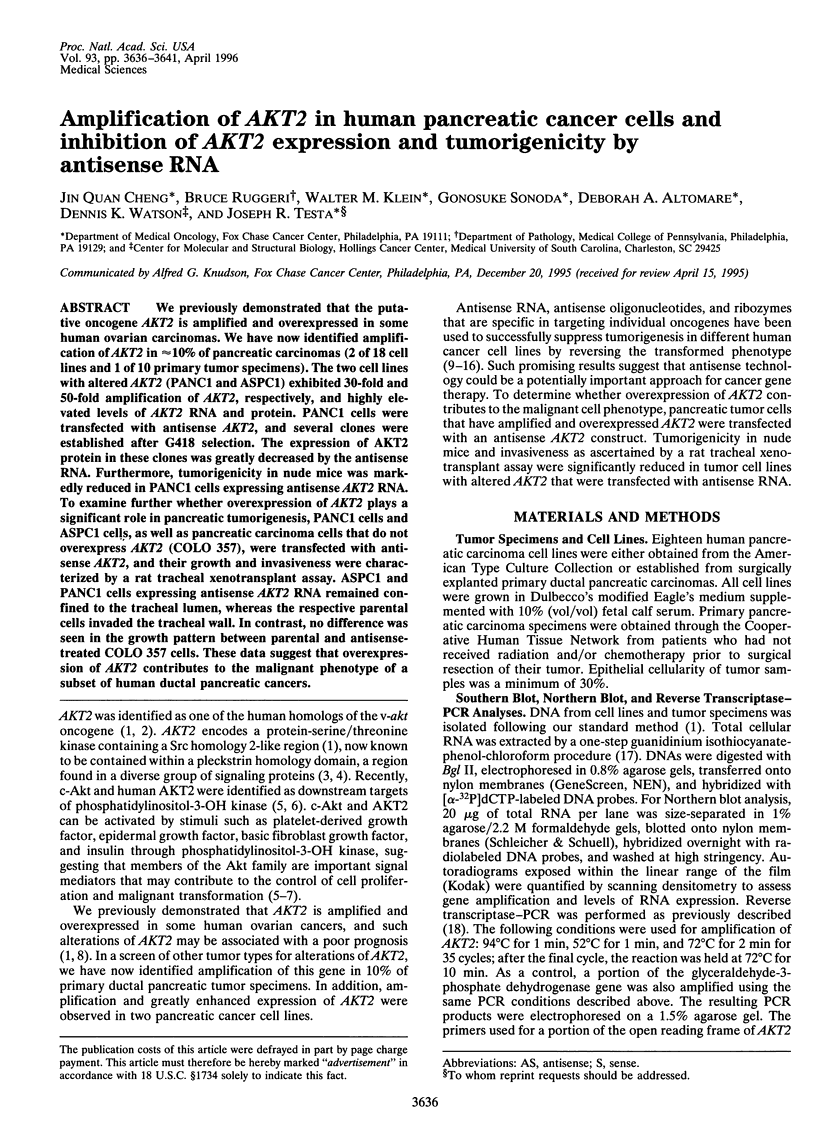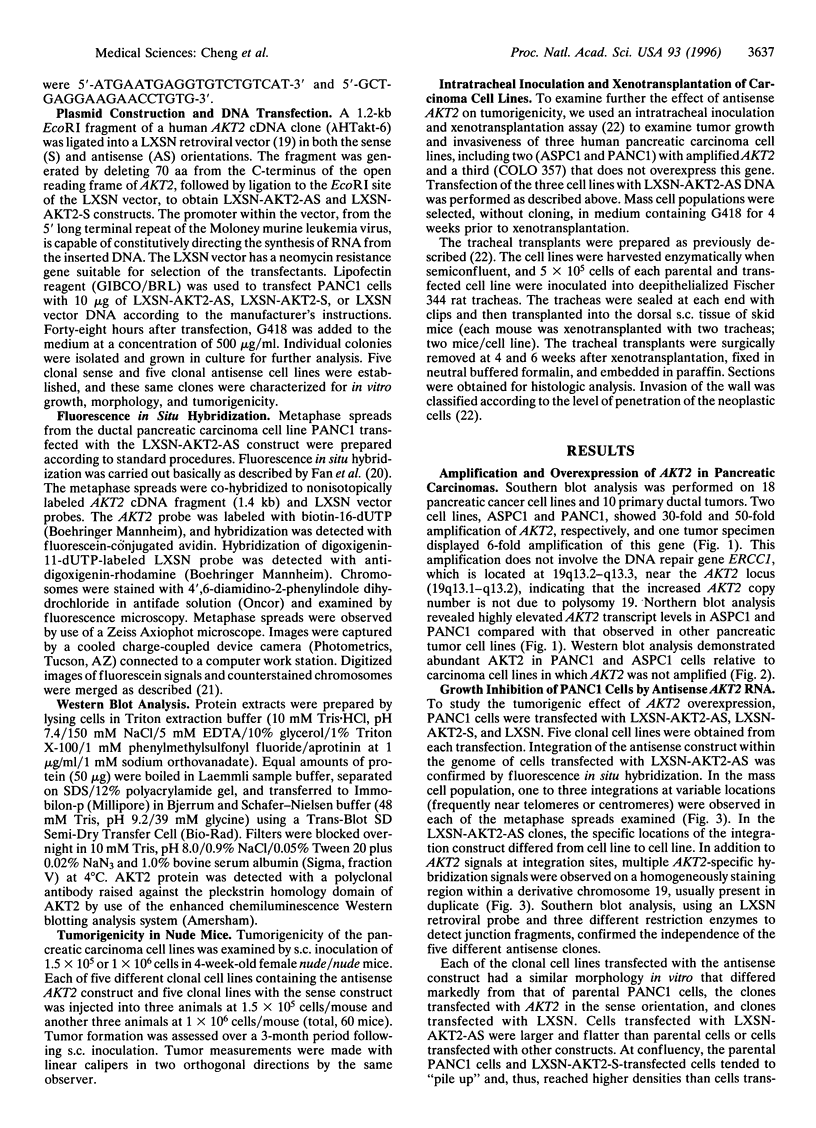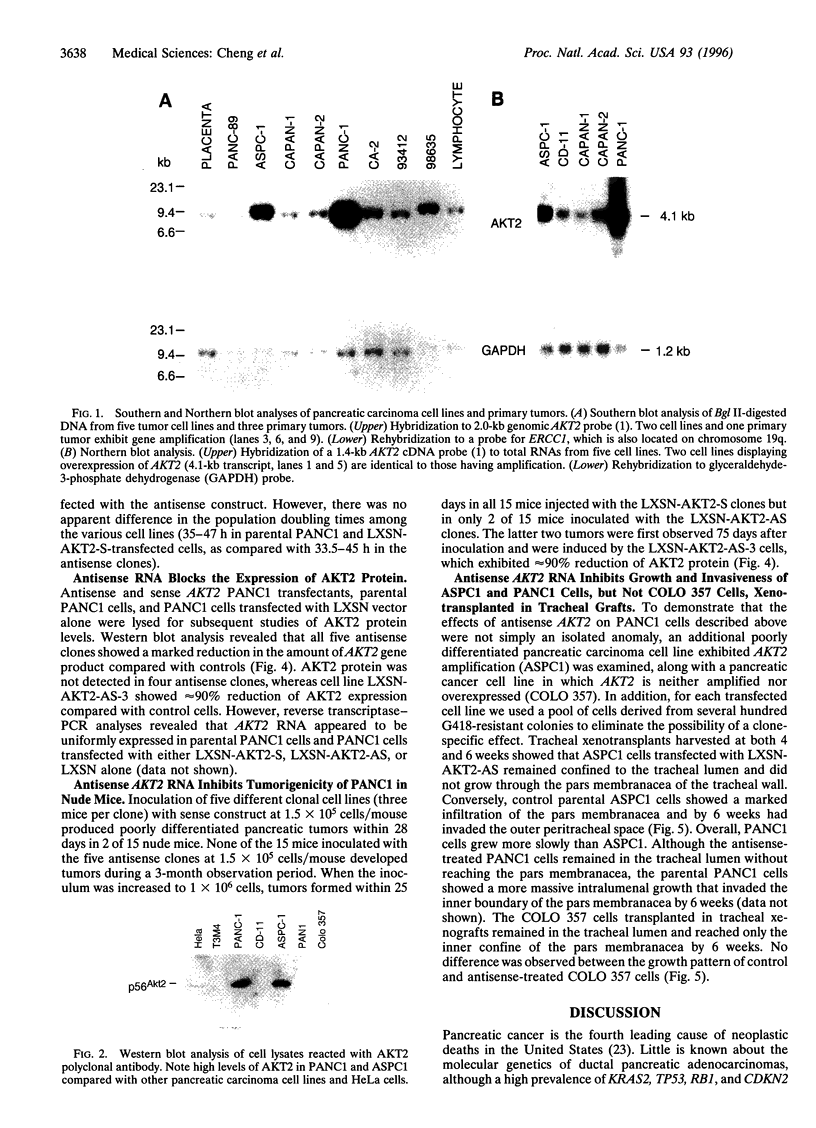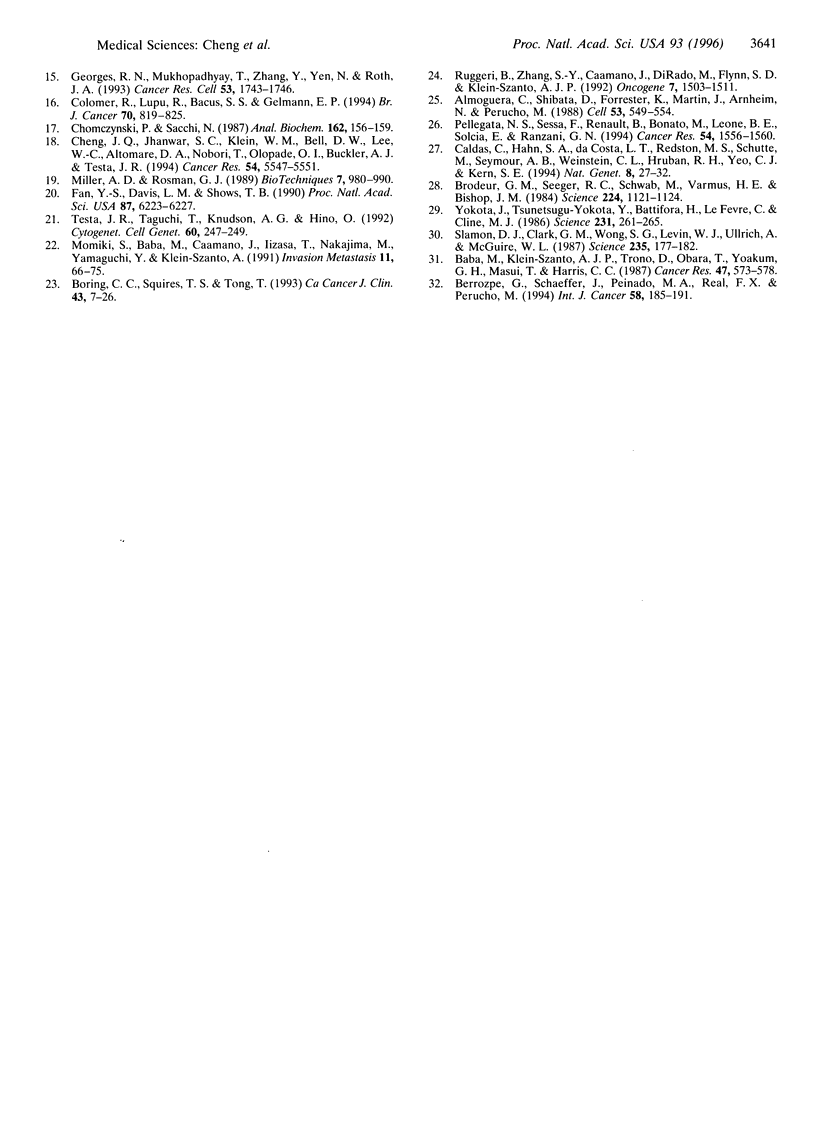Abstract
We previously demonstrated that the putative oncogene AKT2 is amplified and overexpressed in some human ovarian carcinomas. We have now identified amplification of AKT2 in approximately 10% of pancreatic carcinomas (2 of 18 cell lines and 1 of 10 primary tumor specimens). The two cell lines with altered AKT2 (PANC1 and ASPC1) exhibited 30-fold and 50-fold amplification of AKT2, respectively, and highly elevated levels of AKT2 RNA and protein. PANC1 cells were transfected with antisense AKT2, and several clones were established after G418 selection. The expression of AKT2 protein in these clones was greatly decreased by the antisense RNA. Furthermore, tumorigenicity in nude mice was markedly reduced in PANC1 cells expressing antisense AKT2 RNA. To examine further whether overexpression of AKT2 plays a significant role in pancreatic tumorigenesis, PANC1 cells and ASPC1 cells, as well as pancreatic carcinoma cells that do not overexpress AKT2 (COLO 357), were transfected with antisense AKT2, and their growth and invasiveness were characterized by a rat tracheal xenotransplant assay. ASPC1 and PANC1 cells expressing antisense AKT2 RNA remained confined to the tracheal lumen, whereas the respective parental cells invaded the tracheal wall. In contrast, no difference was seen in the growth pattern between parental and antisense-treated COLO 357 cells. These data suggest that overexpression of AKT2 contributes to the malignant phenotype of a subset of human ductal pancreatic cancers.
Full text
PDF





Images in this article
Selected References
These references are in PubMed. This may not be the complete list of references from this article.
- Almoguera C., Shibata D., Forrester K., Martin J., Arnheim N., Perucho M. Most human carcinomas of the exocrine pancreas contain mutant c-K-ras genes. Cell. 1988 May 20;53(4):549–554. doi: 10.1016/0092-8674(88)90571-5. [DOI] [PubMed] [Google Scholar]
- Baba M., Klein-Szanto A. J., Trono D., Obara T., Yoakum G. H., Masui T., Harris C. C. Preneoplastic and neoplastic growth of xenotransplanted lung-derived human cell lines using deepithelialized rat tracheas. Cancer Res. 1987 Jan 15;47(2):573–578. [PubMed] [Google Scholar]
- Bellacosa A., Testa J. R., Staal S. P., Tsichlis P. N. A retroviral oncogene, akt, encoding a serine-threonine kinase containing an SH2-like region. Science. 1991 Oct 11;254(5029):274–277. doi: 10.1126/science.254.5029.274. [DOI] [PubMed] [Google Scholar]
- Bellacosa A., de Feo D., Godwin A. K., Bell D. W., Cheng J. Q., Altomare D. A., Wan M., Dubeau L., Scambia G., Masciullo V. Molecular alterations of the AKT2 oncogene in ovarian and breast carcinomas. Int J Cancer. 1995 Aug 22;64(4):280–285. doi: 10.1002/ijc.2910640412. [DOI] [PubMed] [Google Scholar]
- Berrozpe G., Schaeffer J., Peinado M. A., Real F. X., Perucho M. Comparative analysis of mutations in the p53 and K-ras genes in pancreatic cancer. Int J Cancer. 1994 Jul 15;58(2):185–191. doi: 10.1002/ijc.2910580207. [DOI] [PubMed] [Google Scholar]
- Boring C. C., Squires T. S., Tong T. Cancer statistics, 1993. CA Cancer J Clin. 1993 Jan-Feb;43(1):7–26. doi: 10.3322/canjclin.43.1.7. [DOI] [PubMed] [Google Scholar]
- Brodeur G. M., Seeger R. C., Schwab M., Varmus H. E., Bishop J. M. Amplification of N-myc in untreated human neuroblastomas correlates with advanced disease stage. Science. 1984 Jun 8;224(4653):1121–1124. doi: 10.1126/science.6719137. [DOI] [PubMed] [Google Scholar]
- Burgering B. M., Coffer P. J. Protein kinase B (c-Akt) in phosphatidylinositol-3-OH kinase signal transduction. Nature. 1995 Aug 17;376(6541):599–602. doi: 10.1038/376599a0. [DOI] [PubMed] [Google Scholar]
- Caldas C., Hahn S. A., da Costa L. T., Redston M. S., Schutte M., Seymour A. B., Weinstein C. L., Hruban R. H., Yeo C. J., Kern S. E. Frequent somatic mutations and homozygous deletions of the p16 (MTS1) gene in pancreatic adenocarcinoma. Nat Genet. 1994 Sep;8(1):27–32. doi: 10.1038/ng0994-27. [DOI] [PubMed] [Google Scholar]
- Cheng J. Q., Godwin A. K., Bellacosa A., Taguchi T., Franke T. F., Hamilton T. C., Tsichlis P. N., Testa J. R. AKT2, a putative oncogene encoding a member of a subfamily of protein-serine/threonine kinases, is amplified in human ovarian carcinomas. Proc Natl Acad Sci U S A. 1992 Oct 1;89(19):9267–9271. doi: 10.1073/pnas.89.19.9267. [DOI] [PMC free article] [PubMed] [Google Scholar]
- Cheng J. Q., Jhanwar S. C., Klein W. M., Bell D. W., Lee W. C., Altomare D. A., Nobori T., Olopade O. I., Buckler A. J., Testa J. R. p16 alterations and deletion mapping of 9p21-p22 in malignant mesothelioma. Cancer Res. 1994 Nov 1;54(21):5547–5551. [PubMed] [Google Scholar]
- Chomczynski P., Sacchi N. Single-step method of RNA isolation by acid guanidinium thiocyanate-phenol-chloroform extraction. Anal Biochem. 1987 Apr;162(1):156–159. doi: 10.1006/abio.1987.9999. [DOI] [PubMed] [Google Scholar]
- Colomer R., Lupu R., Bacus S. S., Gelmann E. P. erbB-2 antisense oligonucleotides inhibit the proliferation of breast carcinoma cells with erbB-2 oncogene amplification. Br J Cancer. 1994 Nov;70(5):819–825. doi: 10.1038/bjc.1994.405. [DOI] [PMC free article] [PubMed] [Google Scholar]
- Downward J. Signal transduction. A target for PI(3) kinase. Nature. 1995 Aug 17;376(6541):553–554. doi: 10.1038/376553a0. [DOI] [PubMed] [Google Scholar]
- Fan Y. S., Davis L. M., Shows T. B. Mapping small DNA sequences by fluorescence in situ hybridization directly on banded metaphase chromosomes. Proc Natl Acad Sci U S A. 1990 Aug;87(16):6223–6227. doi: 10.1073/pnas.87.16.6223. [DOI] [PMC free article] [PubMed] [Google Scholar]
- Francastel C., Groisman R., Pfarr C. M., Robert-Lézénès J. Antisense c-jun overcomes a differentiation block in a murine erythroleukemia cell line. Oncogene. 1994 Jul;9(7):1957–1964. [PubMed] [Google Scholar]
- Franke T. F., Yang S. I., Chan T. O., Datta K., Kazlauskas A., Morrison D. K., Kaplan D. R., Tsichlis P. N. The protein kinase encoded by the Akt proto-oncogene is a target of the PDGF-activated phosphatidylinositol 3-kinase. Cell. 1995 Jun 2;81(5):727–736. doi: 10.1016/0092-8674(95)90534-0. [DOI] [PubMed] [Google Scholar]
- Georges R. N., Mukhopadhyay T., Zhang Y., Yen N., Roth J. A. Prevention of orthotopic human lung cancer growth by intratracheal instillation of a retroviral antisense K-ras construct. Cancer Res. 1993 Apr 15;53(8):1743–1746. [PubMed] [Google Scholar]
- Gray G. D., Hernandez O. M., Hebel D., Root M., Pow-Sang J. M., Wickstrom E. Antisense DNA inhibition of tumor growth induced by c-Ha-ras oncogene in nude mice. Cancer Res. 1993 Feb 1;53(3):577–580. [PubMed] [Google Scholar]
- Kasid U., Pfeifer A., Brennan T., Beckett M., Weichselbaum R. R., Dritschilo A., Mark G. E. Effect of antisense c-raf-1 on tumorigenicity and radiation sensitivity of a human squamous carcinoma. Science. 1989 Mar 10;243(4896):1354–1356. doi: 10.1126/science.2466340. [DOI] [PubMed] [Google Scholar]
- Mayer B. J., Ren R., Clark K. L., Baltimore D. A putative modular domain present in diverse signaling proteins. Cell. 1993 May 21;73(4):629–630. doi: 10.1016/0092-8674(93)90244-k. [DOI] [PubMed] [Google Scholar]
- Miller A. D., Rosman G. J. Improved retroviral vectors for gene transfer and expression. Biotechniques. 1989 Oct;7(9):980-2, 984-6, 989-90. [PMC free article] [PubMed] [Google Scholar]
- Momiki S., Baba M., Caamano J., Iizasa T., Nakajima M., Yamaguchi Y., Klein-Szanto A. In vivo and in vitro invasiveness of human lung carcinoma cell lines. Invasion Metastasis. 1991;11(2):66–75. [PubMed] [Google Scholar]
- Musacchio A., Gibson T., Rice P., Thompson J., Saraste M. The PH domain: a common piece in the structural patchwork of signalling proteins. Trends Biochem Sci. 1993 Sep;18(9):343–348. doi: 10.1016/0968-0004(93)90071-t. [DOI] [PubMed] [Google Scholar]
- Pellegata N. S., Sessa F., Renault B., Bonato M., Leone B. E., Solcia E., Ranzani G. N. K-ras and p53 gene mutations in pancreatic cancer: ductal and nonductal tumors progress through different genetic lesions. Cancer Res. 1994 Mar 15;54(6):1556–1560. [PubMed] [Google Scholar]
- Ruggeri B., Zhang S. Y., Caamano J., DiRado M., Flynn S. D., Klein-Szanto A. J. Human pancreatic carcinomas and cell lines reveal frequent and multiple alterations in the p53 and Rb-1 tumor-suppressor genes. Oncogene. 1992 Aug;7(8):1503–1511. [PubMed] [Google Scholar]
- Schmidt M. L., Salwen H. R., Manohar C. F., Ikegaki N., Cohn S. L. The biological effects of antisense N-myc expression in human neuroblastoma. Cell Growth Differ. 1994 Feb;5(2):171–178. [PubMed] [Google Scholar]
- Slamon D. J., Clark G. M., Wong S. G., Levin W. J., Ullrich A., McGuire W. L. Human breast cancer: correlation of relapse and survival with amplification of the HER-2/neu oncogene. Science. 1987 Jan 9;235(4785):177–182. doi: 10.1126/science.3798106. [DOI] [PubMed] [Google Scholar]
- Stein C. A., Cheng Y. C. Antisense oligonucleotides as therapeutic agents--is the bullet really magical? Science. 1993 Aug 20;261(5124):1004–1012. doi: 10.1126/science.8351515. [DOI] [PubMed] [Google Scholar]
- Szczylik C., Skorski T., Nicolaides N. C., Manzella L., Malaguarnera L., Venturelli D., Gewirtz A. M., Calabretta B. Selective inhibition of leukemia cell proliferation by BCR-ABL antisense oligodeoxynucleotides. Science. 1991 Aug 2;253(5019):562–565. doi: 10.1126/science.1857987. [DOI] [PubMed] [Google Scholar]
- Testa J. R., Taguchi T., Knudson A. G., Hino O. Localization of the interferon-alpha gene cluster to rat chromosome bands 5q31----q33 by fluorescence in situ hybridization. Cytogenet Cell Genet. 1992;60(3-4):247–249. doi: 10.1159/000133350. [DOI] [PubMed] [Google Scholar]
- Yokota J., Tsunetsugu-Yokota Y., Battifora H., Le Fevre C., Cline M. J. Alterations of myc, myb, and rasHa proto-oncogenes in cancers are frequent and show clinical correlation. Science. 1986 Jan 17;231(4735):261–265. doi: 10.1126/science.3941898. [DOI] [PubMed] [Google Scholar]







